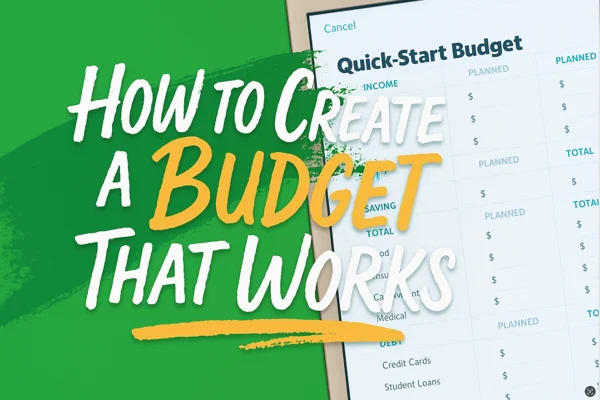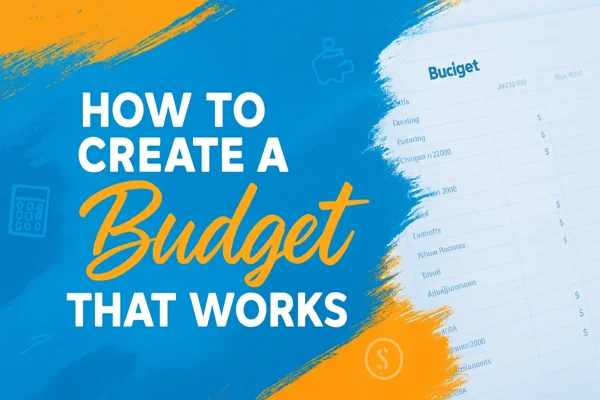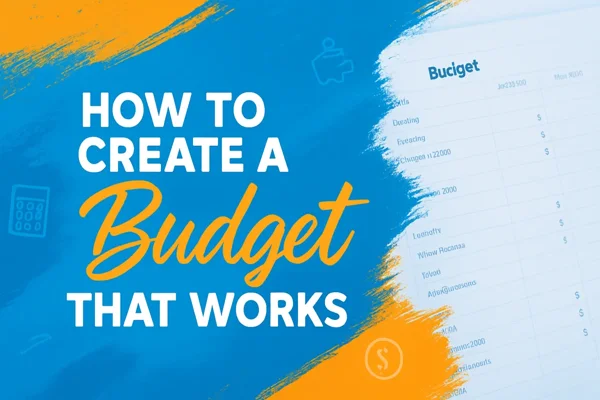Introduction: How to Create a Budget That Works
Learning how to create a budget that works is one of the most powerful tools you can use to take control of your financial life. Whether you’re trying to pay off debt, save for a house, or simply stop living paycheck to paycheck, budgeting gives you a clear roadmap for your money. Yet, despite its importance, many people find personal budgeting confusing, stressful, or just too overwhelming to start.
But here’s the truth: budgeting doesn’t have to be complicated. In fact, the best budgeting strategies are simple, realistic, and tailored to your actual lifestyle. A good budget helps you understand where your money is going, gives every dollar a purpose, and keeps you focused on your goals.
When done right, budgeting can relieve stress, improve relationships, and create long-term financial stability. The key lies in building a system that actually works for you, not one based on what others are doing or what a budgeting app says.
This article will walk you through 10 practical, proven steps to help you master how to create a budget that works, not just for one month, but for the long haul. Whether you’re a budgeting beginner or someone who’s tried and failed before, this guide will give you the clarity, tools, and confidence to finally make your money work for you.
Let’s dive in and build a budget you can actually stick to; one that reflects your goals, adapts to your needs, and ultimately supports the life you want to live.
1. How to create a budget that works: Understand Your Income
To build any financial plan, the first step in mastering how to create a budget that works is knowing exactly how much money you bring in. Your income isn’t just your salary; it includes side hustle earnings, freelance projects, rental property income, dividends, child support, and even government assistance. A budget’s success depends on how accurate this starting number is.
Why This Matters
Many people make the mistake of budgeting based on assumptions or expected pay instead of actual numbers. This often leads to overspending because what’s in your head doesn’t match what hits your bank account. The true foundation of how to create a budget that works lies in understanding your net income; the amount you actually take home after taxes and deductions. Without this clarity, your entire budget rests on shaky ground.
Action Steps to Take
Gather pay stubs or bank statements from the past 2–3 months.
Calculate your net income (after taxes and payroll deductions).
Include irregular income such as freelance work, commissions, or side gigs.
Average your monthly income if it fluctuates throughout the year.
Pro Tip
If your income varies month to month, base your budget on your lowest earning month. That way, you’ll avoid overspending during leaner times and build a cushion during higher-earning months. This proactive approach shows you not just where your money comes from, but also how to create a budget that works even when life is unpredictable.
2. How to Create a Budget That Works: Track Your Expenses
Once you know how much money is coming in, the next step in learning how to create a budget that works is knowing exactly where it’s going. You can’t control what you don’t track, and this step provides the clarity you need to make smarter financial choices.
For many beginners, this is the most eye-opening part of the process. Tracking reveals the hidden leaks in your finances; those $5 lattes, multiple streaming services, or impulse buys that quietly drain hundreds of dollars every month. Understanding how to create a budget that works begins with shining a light on those habits.
What to Track
Tools You Can Use
Why It Works
By tracking every dollar, you gain a true picture of your spending habits. Many people claim, “I don’t know where my money goes.” When you commit to monitoring, that question disappears. You’ll see patterns clearly, and you’ll know exactly what changes are needed to create balance. This is the foundation of how to create a budget that works in real life.
Bonus Tip
Track your spending for at least 30 days before making adjustments. This ensures your budget reflects your actual lifestyle rather than assumptions. Once you’ve built awareness, you can cut waste and reallocate funds toward what matters most. The more intentional you become, the easier it is to master how to create a budget that works for the long term.
3. How to create a budget that works: Set Realistic Financial Goals
Budgeting isn’t just about cutting back, it’s about creating space for your dreams. One of the biggest reasons people struggle with budgeting is because they only focus on restrictions, not aspirations. To truly learn how to create a budget that works, you must anchor it to clear and motivating goals.
Types of Goals to Include
- Short-term goals: Pay off a credit card balance, build a $1,000 emergency fund.
- Mid-term goals: Save for a vacation, pay off a car loan, or set aside funds for a new laptop.
- Long-term goals: Buy a home, invest for retirement, or achieve total debt freedom.
How to Set Them Effectively
- Use the SMART method: Specific, Measurable, Achievable, Relevant, and Time-bound.
- Write your goals down and place them somewhere visible as a daily reminder.
- Break large goals into smaller, manageable milestones that fit into your budget plan.
Why This Matters
Financial goals give your money direction. Every choice you make, whether you decide to cook at home or order takeout, you should connect back to your priorities. Without goals, it’s easy to lose motivation and fall off track. But when you understand how to create a budget that works, your goals become the driving force that turns your plan into a lifestyle.
Ultimately, goals transform your budget from a list of numbers into a roadmap for the life you want. This shift is what makes the difference between simply tracking expenses and truly mastering how to create a budget that works for the long term.
4. How to create a budget that works: Choose the Right Budgeting Method
There’s no “one-size-fits-all” approach when it comes to money management. If you want to truly understand how to create a budget that works, you must choose a method that fits your income style, personality, and long-term goals. A budget isn’t about following trends, it’s about finding a system that matches your lifestyle so you can stay consistent.
Popular Budgeting Methods
The 50/30/20 Rule
50% for needs (housing, groceries, utilities)
30% for wants (entertainment, dining out, hobbies)
20% for savings and debt repaymentThis method is simple, flexible, and perfect for beginners who want a quick framework without overcomplicating their finances.
2. Zero-Based Budgeting
Every dollar you earn is assigned a job, from bills to savings to fun money. By the end of the month, your income minus expenses equals zero. This approach is ideal for those who want total control and accountability over every cent.
3. The Envelope System (Cash-Based)
Cash is divided into envelopes labeled by category (groceries, gas, entertainment, etc.). When the money runs out, spending in that category stops. This is excellent for visual learners or people trying to break overspending habits.
4. Pay Yourself First
Before covering any expenses, a set percentage of income goes directly into savings or investments. This ensures you prioritize wealth-building and financial security above all else. It works best for long-term savers and those who want to grow assets quickly.
5. How to create a budget that works: Create and Allocate Spending Categories
Once you’ve chosen your budgeting method, the next step in learning how to create a budget that works is building structure through spending categories. A budget without categories is just numbers on paper. Categories make it real, actionable, and easier to follow.
Common Spending Categories
How to Allocate Effectively
Use your tracked expenses from Step 2 as a baseline. Calculate averages for each category and then make adjustments to reflect your goals from Step 3. For example, if you want to save more, you may reduce your entertainment category and redirect that money into investments or an emergency fund. This balance is the heart of how to create a budget that works for your lifestyle instead of against it.
Why This Step Matters
Spending categories create clarity and accountability. Instead of wondering where your money went, you’ll know exactly how much is allocated for each area of your life. Over time, this practice shows you patterns, highlights overspending, and makes it easier to redirect money toward bigger goals. This process is how you transform theory into practice and truly master how to create a budget that works in daily life.
6. How to Create a Budget That Works: Use Budgeting Tools and Apps
Technology has made money management easier than ever, and it can play a huge role in mastering how to create a budget that works. You no longer have to calculate everything manually unless you enjoy the process. With the right app, you can track spending, categorize expenses, and even get reminders to keep your goals on track.
Popular Budgeting Apps to Try
What These Tools Can Do for You
If you’re serious about learning how to create a budget that works, choosing a tool that matches your comfort level can make all the difference. Some people prefer highly detailed apps like YNAB, while others do better with user-friendly dashboards like Mint or EveryDollar. The key is finding a system you’ll actually stick with.
By letting these apps do the heavy lifting, you’ll free up mental space and remove the guesswork from your financial routine. Over time, this consistency will help you master how to create a budget that works seamlessly, turning budgeting from a chore into a habit that supports your bigger goals.
7. How to create a budget that works: Monitor and Adjust Regularly
Budgets are not “set it and forget it” systems. Life changes — income shifts, emergencies arise, and new goals take shape. If you want to master how to create a budget that works, you must treat it as a living document that evolves with you.
The best practice is to check in weekly and then perform a full review at the end of each month. This consistency allows you to stay ahead of problems instead of reacting when it’s too late. Many people fail at budgeting because they set up a plan once and never revisit it, but reviewing regularly is the real secret to how to create a budget that works long term.
What to Look For During Reviews
- Categories consistently over or under budget: If you always overspend on groceries or underspend on transportation, adjust your numbers to reflect reality.
- Unexpected charges: Catching these early keeps them from snowballing into debt.
- Opportunities to save more or spend less: Small tweaks, like cutting one subscription, can free up cash for bigger goals.
Flexibility is the key to sustainability. By adjusting your budget monthly, you ensure it reflects your actual life instead of an unrealistic ideal. This adaptability is proof that you’ve learned how to create a budget that works in the real world, not just on paper.
8. How to create a budget that works: Prepare for Emergencies and Irregular Expenses
A strong budget doesn’t just cover today’s needs — it also protects you from tomorrow’s surprises. If you’re serious about learning how to create a budget that works, you need to plan for both emergencies and irregular expenses that don’t show up every month. Things like car repairs, annual subscriptions, back-to-school costs, or holiday shopping can derail your finances if you don’t prepare in advance.
Why This Step Matters
Many people make the mistake of only budgeting for monthly bills, but when an unexpected medical bill or annual insurance premium arrives, they scramble and often fall back on credit cards. This cycle creates stress and debt instead of stability. Building protection into your plan is one of the most important steps in mastering how to create a budget that works for the long haul.
Tips to Stay Prepared
- Create a category called “Sinking Funds”: These are mini savings buckets for specific goals like car maintenance, vacations, or Christmas gifts.
- Contribute regularly: Aim to put aside $25–$100 per month for each sinking fund, depending on your priorities.
- Build a starter emergency fund: Save at least $1,000 as quickly as possible to handle unexpected expenses without panic. Once that’s complete, work toward 3–6 months of living expenses.
By setting aside money consistently, you’ll avoid the stress of scrambling when life happens. This financial cushion proves that you understand how to create a budget that works not just for daily living but also for future peace of mind.
9. How to create a budget that works: Make Saving a Priority
Saving money should never be an afterthought. If you want to master how to create a budget that works, you need to treat savings as a fixed expense, not what’s “left over” after bills and fun. The best approach is to decide how much you’ll save first, automate it, and make it part of your financial routine.
Why Saving Comes First
When you build savings into your plan, you create stability and reduce financial stress. This is the backbone of how to create a budget that works because it ensures your future goals aren’t pushed aside by short-term spending. Even if you can only start small, the habit matters more than the amount.
Where to Start
The Bigger Picture
Savings isn’t just about numbers, it’s about freedom, flexibility, and peace of mind. By paying yourself first, you give yourself options: the ability to take opportunities, handle emergencies, or retire with confidence. This is the essence of how to create a budget that works for the long term. A plan that doesn’t just help you survive, but thrive.
10. How to create a budget that works: Stay Accountable and Stay Motivated
Even the most well-crafted budget can fall apart without accountability. If you truly want to succeed in learning how to create a budget that works, you need systems in place to keep you motivated and on track. Budgeting is less about perfection and more about showing up consistently.
How to Stay Motivated
Why Accountability Matters
Accountability creates consistency, and consistency is what transforms budgeting from a chore into a lifestyle. By checking in regularly and celebrating small wins, you build the habits that prove you understand how to create a budget that works in everyday life. Motivation alone won’t sustain you, but accountability combined with discipline will.
The Lifestyle Shift
At its core, budgeting isn’t just about dollars and cents, it’s about mindset. Once you embrace the idea that money management is part of who you are, sticking to your plan feels natural. That shift is the true measure of how to create a budget that works not just for a month, but for a lifetime.
Final Thoughts: How to create a budget that works – Building a Budget That Actually Works
Learning how to create a budget that works isn’t just about money, it’s about freedom, confidence, and control over your life. Most people aren’t taught this in school. Many don’t grow up in homes where money is discussed openly or positively. That’s why starting this journey no matter your background is a powerful and courageous step.
A functional budget is more than numbers. It’s a reflection of your values, priorities, and goals. When you build a budget that aligns with your life, not someone else’s — it becomes a tool for empowerment rather than a source of restriction. The real power of learning how to create a budget that works lies in building one that supports your dreams while keeping you financially grounded.
Remember, the budget you create today doesn’t have to be perfect. It’s meant to evolve as your life does. Maybe you’ll start with a simple 50/30/20 rule and later shift into zero-based budgeting when your goals get sharper. That flexibility is a strength and every time you revisit your plan, you’ll understand better how to create a budget that works for your changing needs.
And it’s okay to stumble. Maybe you’ll overspend in the entertainment category one month or forget to track for a few days. That doesn’t mean budgeting isn’t for you, it means you’re human. What matters is showing up again, adjusting, and staying committed to your bigger vision. These small setbacks are actually lessons in discovering how to create a budget that works for your lifestyle instead of against it.
As you practice and grow, budgeting will feel less like a chore and more like a natural rhythm of your life. You’ll gain confidence in your decisions, reduce money stress, and open doors to opportunities that once felt out of reach.
Ultimately, creating a budget that works is one of the greatest gifts you can give yourself. It’s not about deprivation, it’s about direction. And the sooner you take that step, the sooner you move toward the life you truly want.
Ready to take control of your money? Start learning how to create a budget that works today and build the financial freedom you deserve. Read more budgeting tips here »








